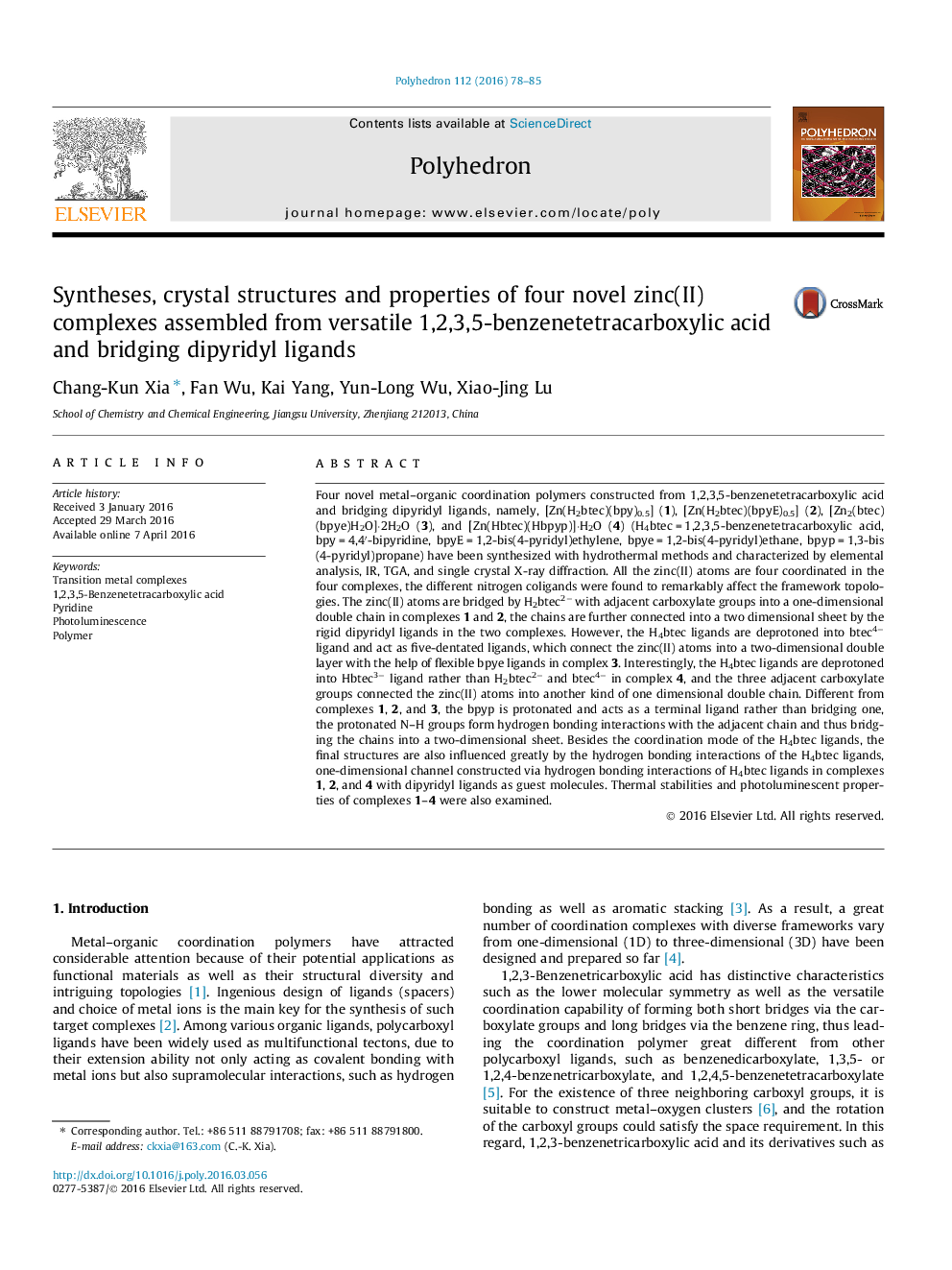| کد مقاله | کد نشریه | سال انتشار | مقاله انگلیسی | نسخه تمام متن |
|---|---|---|---|---|
| 1335074 | 1500228 | 2016 | 8 صفحه PDF | دانلود رایگان |

Four novel metal–organic coordination polymers constructed from 1,2,3,5-benzenetetracarboxylic acid and bridging dipyridyl ligands, namely, [Zn(H2btec)(bpy)0.5] (1), [Zn(H2btec)(bpyE)0.5] (2), [Zn2(btec)(bpye)H2O]·2H2O (3), and [Zn(Hbtec)(Hbpyp)]·H2O (4) (H4btec = 1,2,3,5-benzenetetracarboxylic acid, bpy = 4,4′-bipyridine, bpyE = 1,2-bis(4-pyridyl)ethylene, bpye = 1,2-bis(4-pyridyl)ethane, bpyp = 1,3-bis(4-pyridyl)propane) have been synthesized with hydrothermal methods and characterized by elemental analysis, IR, TGA, and single crystal X-ray diffraction. All the zinc(II) atoms are four coordinated in the four complexes, the different nitrogen coligands were found to remarkably affect the framework topologies. The zinc(II) atoms are bridged by H2btec2− with adjacent carboxylate groups into a one-dimensional double chain in complexes 1 and 2, the chains are further connected into a two dimensional sheet by the rigid dipyridyl ligands in the two complexes. However, the H4btec ligands are deprotoned into btec4− ligand and act as five-dentated ligands, which connect the zinc(II) atoms into a two-dimensional double layer with the help of flexible bpye ligands in complex 3. Interestingly, the H4btec ligands are deprotoned into Hbtec3− ligand rather than H2btec2− and btec4− in complex 4, and the three adjacent carboxylate groups connected the zinc(II) atoms into another kind of one dimensional double chain. Different from complexes 1, 2, and 3, the bpyp is protonated and acts as a terminal ligand rather than bridging one, the protonated N–H groups form hydrogen bonding interactions with the adjacent chain and thus bridging the chains into a two-dimensional sheet. Besides the coordination mode of the H4btec ligands, the final structures are also influenced greatly by the hydrogen bonding interactions of the H4btec ligands, one-dimensional channel constructed via hydrogen bonding interactions of H4btec ligands in complexes 1, 2, and 4 with dipyridyl ligands as guest molecules. Thermal stabilities and photoluminescent properties of complexes 1–4 were also examined.
Four zinc(II) coordination complexes were prepared under hydrothermal methods by the reaction of 1,2,3,5-benzenetrtracarboxylic acid and zinc(II) salts with bridging dipyridyl ligands as auxiliary coligands. When rigid bpy and bpyE were used, similar framework with (410·54·67)(43·53) topology constructed via hydrogen bonding interactions were obtained in complexes 1 and 2. However, a two-dimensional double layer with (4·5·6)(42·53·6)(43·53·62·72) topology was obtained in complex 3 when flexible bpye being used as coligand. While in complex 4, another hydrogen bonding framework with (42·611·82)(42·64) topology displayed when bpyp was used. In complex 1, 2 and 4, one-dimensional channel constructed via hydrogen bonding demonstrated with the bridging dipyridyl ligands act as guest molecules. The different nitrogen coligands were found to remarkably affect the framework topologies.Figure optionsDownload as PowerPoint slide
Journal: Polyhedron - Volume 112, 7 July 2016, Pages 78–85